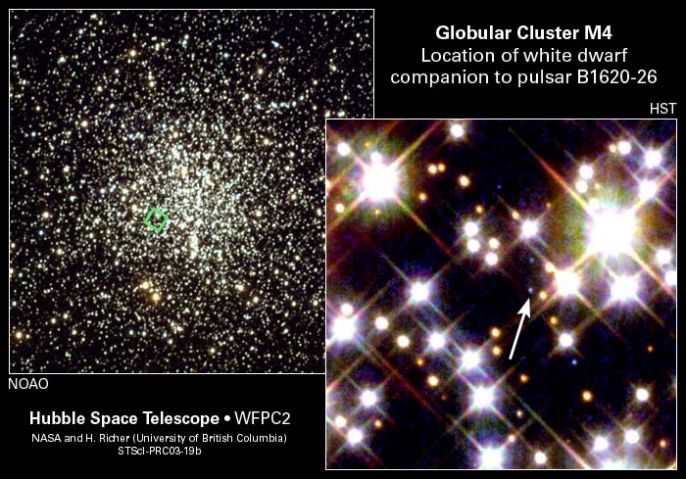
|
Explanation: A planet, a white dwarf, and a neutron star orbit each other in the giant globular star cluster M4, some 5,600 light-years away. The most visible member of the trio is the white dwarf star, indicated above in an image from the Hubble Space Telescope, while the neutron star is detected at radio frequencies as a pulsar. A third body was known to be present in the pulsar/white dwarf system and a detailed analysis of the Hubble data has indicated it is indeed a planet with about 2.5 times the mass of Jupiter. In such a system, the planet is likely to be about 13 billion years old. Compared to our solar system's tender 4.5 billion years and other identified planets of nearby stars, this truly ancient world is by far the oldest planet known, almost as old as the Universe itself. Its discovery as part of an evolved cosmic trio suggests that planet formation spans the age of the Universe and that this newly discovered planet is likely only one of many formed in the crowded environs of globular star clusters.
|
January February March April May June July August September October November December |
| ||||||||||||||||||||||||||||||||||||||||||||||||
NASA Web Site Statements, Warnings, and Disclaimers
NASA Official: Jay Norris. Specific rights apply.
A service of: LHEA at NASA / GSFC
& Michigan Tech. U.
Based on Astronomy Picture
Of the Day
Publications with keywords: pulsar - white dwarf - extrasolar planet - neutron star - globular cluster
Publications with words: pulsar - white dwarf - extrasolar planet - neutron star - globular cluster
See also:
- APOD: 2025 November 26 Á Globular Cluster M15 Deep Field
- APOD: 2025 September 8 Á IRAS 04302: Butterfly Disk Planet Formation
- APOD: 2025 September 5 Á 47 Tucanae: Globular Star Cluster
- APOD: 2025 September 3 Á Cir X1: Jets in the Africa Nebula
- APOD: 2025 August 24 Á The Spinning Pulsar of the Crab Nebula
- APOD: 2025 August 14 Á M13: The Great Globular Cluster in Hercules
- APOD: 2025 July 26 Á Globular Cluster Omega Centauri
